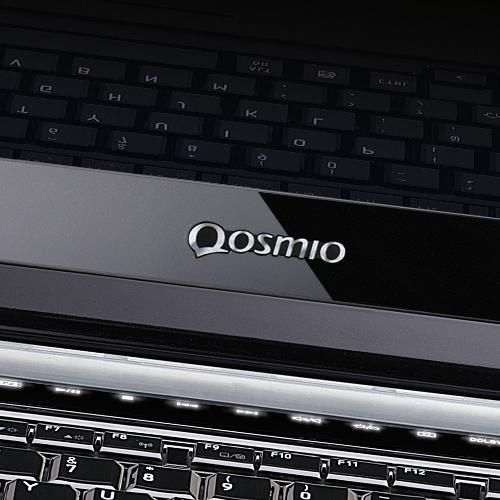Over the past few years Toshiba’s Qosmio range has led the field when it comes to multimedia laptops. Following the death of HD DVD, however, and Toshiba’s pigheadedness in refusing to adopt Blu-ray, can the latest Qosmio laptops compete with high-end rivals?
Our quick take
The Qosmio G50-115 is a great laptop, but it’s difficult not to feel let down by the lack of true HD support. With rivals all offering Blu-ray drives in their laptops, Toshiba’s current conviction that DVD upscaling is the way to go smacks of desperation, although it does actually work well enough for those simply wanting to watch movies on the small screen.
If that’s you, and you don’t mind accepting a slightly lower resolution, the G50-115 is a bit of a bargain. It offers most of the features of the £300 more expensive G50-10H, and similar everyday performance, despite a slower processor; the only thing you’ll really be missing out on is the outstandingly sharp 1080p screen.

Toshiba Qosmio G50-115 notebook - 4.0 / 5
| FOR | AGAINST |
|---|---|
|
|
On paper, the Qosmio G50-115 looks every bit the modern multimedia laptop, featuring powerful graphics, ultra-large display and a raft of features to keep the entire family occupied for weeks.
The screen is a stunner. Measuring 18.4 inches it’ll easily replace the TV in your spare room. We found it bright and even across the panel, with colours looking true to life. However, as the entry-level G50, you’ll find it comes with a resolution of 1680 x 945 pixels - somewhat down on the Full HD panel offered on the £1369 G50-10H. We still found movie playback above average though, again aided by the vivid colours on offer.
In place of a high-definition Blu-ray drive, you’ll find Toshiba’s Quad Core HD processor in place - technology that promises to upscale standard DVD footage to HD quality. But does it work? If your only intention is to watch movies on the laptop itself, the Qosmio presents a fairly compelling case, with crisp image quality that didn’t leave us crying for a sharper picture.
At this price, however, rival machines offer both Blu-ray and HDMI, letting you hook-up an external display and play back Blu-ray movies in all their glory; on a larger panel upscaled DVDs simply don’t look as convincing as Full HD content.
Thanks to a mainstream Nvidia GeForce 9600M GT graphics card, we found games like Crysis ran with relative ease, as long as the settings weren’t too demanding. It’s still possible to run the latest titles with enough detail to look good, making the G50 a useful addition for all types of users.
Finished in a mixture of chrome-effect and glossy black plastics, stylistically the G50 is a love-it or loath-it affair. It is a fairly cohesive design, however, and build quality can’t be faulted. The plastics proved tough, with the massive screen held firmly in place. It’s a shame to see the tactile brushed aluminium finish of older Qosmios completely replaced, however, especially with high-end Sony VAIO AW laptops finished in magnesium alloy.
The keyboard is excellent, with large tapered keys that make it near impossible to make mistakes when typing. It may lack the sloped effect of a proper desktop keyboard, but it’s definitely the next best thing. As with other Toshiba laptops, we’re not convinced by the glossy coating though, picking up grime and fingerprints well within the first day we had it.
Those who do opt to use the G50 as a media hub in their spare room will be happy to find the inclusion of an integrated digital/analogue TV tuner. Speakers by audio company Harman Kardon proved better than the average laptop, but it’s still no match for a proper stereo or dedicated speaker setup.
There’s a remote control for those who can’t be bothered to move, and when that inevitably gets lost you can even control the G50 by shaking your fist at it. Surprisingly, the chip that helps to upscale DVDs, also works with the laptop’s 1.3-megapixel webcam to provide gesture recognition, letting you control applications such as Microsoft’s Media Centre by calmly moving your hands around in a somewhat demented fashion.
Processing power is down on the high-end G50-10H - with a 2.26GHz Intel Core 2 Duo chip in place of a 2.53GHz processor. It’s backed by the same 4096MB of memory, however, and we still found everyday performance to be much better than average. Windows loaded quickly, and we found the system ran smoothly at all times. Storage space comes in the form of two 250GB hard drives, so you’ll be able to choose between maximum storage or security, using the second drive for backup.
There’s a full complement of ports in place for your peripherals, including four USB ports, an eSATA interface, 1394 FireWire and VGA and HDMI-out. There’s also a 5-in-1 memory card reader, along with an ExpressCard 54 slot. Bluetooth is provided for wireless data transfers.
To recap
Toshiba’s entry-level G50 is crammed with features and offers excellent quality, and only the lack of support for Full HD lets it down
